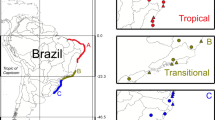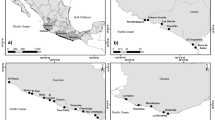Abstract
We investigated the potential associations of habitat type richness patterns with a series of environmental variables in 61 protected aquatic ecosystems of the Greek Natura 2000 network. Habitat type classification followed the Natura 2000 classification scheme. Habitat type richness was measured as the number of different habitat types in an area. To overcome a potential area effect in quantifying habitat type richness, we applied the “moving window” technique. The environmental variables were selected to account for some of the major threats to biodiversity, such as fragmentation, habitat loss and climate change. We run GLMs to associate habitat type richness with different combinations of climatic, spatial and topographic variables. Habitat type richness seemed to significantly associate with climatic variables, more than spatial or topographic ones. In particular, for the climatic ones, the importance of precipitation surpassed that of temperature and especially the precipitation of the wettest and driest month had a limiting contribution to richness unlike average climate estimators. Moreover, the landscape’s latitude and longitude and fragmentation were significantly associated to richness. Our findings are in accordance to those observed in recent literature at lower (i.e. species) levels of ecological organization, fact showing that large-scale phenomena (such as climate change) can also be observed at the habitat type level, at least in our case. Thus, following the context of the Habitats Directive (92/43/EEC), that habitat types and not solely species of community interest should be protected and restored, this study serves as a first step towards investigating habitat type richness patterns.


Similar content being viewed by others
Abbreviations
- EEC:
-
European ecological community
- EC:
-
European commission
- GLM:
-
Generalized linear model
- AIC:
-
Akaike’s information criterion
- ΔAIC:
-
Difference in AIC values
- IPCC:
-
Intergovernmental panel on climate change
- SD:
-
Standard deviation
- CV:
-
Coefficient of variation
References
Abrahams C (2008) Climate change and lakeshore conservation: a model and review of management techniques. Hydrobiologia 613:33–43
Apostolopoulou E, Pantis JD (2009) Conceptual gaps in the national strategy for the implementation of the European Natura 2000 conservation policy in Greece. Biol Conserv 142:221–237
Ashcroft MB, Chisholm LA, French KO (2009) Climate change at the landscape scale: predicting fine-grained spatial heterogeneity in warming and potential refugia for vegetation. Glob Change Biol 15:656–667
Barrett TL, Farina A, Barrett GW (2009) Aesthetic landscapes: an emergent component in sustaining societies. Landscape Ecol 24:1029–1035
Beale CM, Lennon JJ, Gimona A (2008) Opening the climate envelope reveals no macroscale associations with climate in European birds. Proc Natl Acad Sci 105:14908–14912
Chiarucci A, Bacaro G, Rocchini D (2008) Quantifying plant species diversity in a Natura 2000 network: old ideas and new proposals. Biol Conserv 141:2608–2618
Commission of European Communities (DG XI-B2) (1994) Natura 2000 network standard data form. Office for Publications of the European Communities, Brussels
Communication from the Commission to the European Parliament, the Council, the European Economic and Social Committee and the Committee of the Regions (COM) (2010) Options for an EU vision and target for biodiversity beyond 2010. Office for Publications of the European Communities, Brussels
Cumming GS, Cumming DHM, Redman CL (2006) Scale mismatches in social-ecological systems: causes, consequences and solutions. Ecol Soc 11:14–33
Dafis S, Papastergiadou E, Georgiou K et al. (1997) Directive 92/43/EEC. The Greek “Habitat” Project Natura 2000: An Overview. Commission of the European Communities DG XCI, The Goulandris Natural History Museum-Greek biotope/Wetland Centre, Greece
Dawson TP, Berry PM, Kampa E (2003) Climate change impacts on freshwater wetland habitats. J Nat Conserv 11:25–30
Debinski DM, Holt RD (2000) A survey and overview of habitat fragmentation experiments. Conserv Biol 14:342–355
Díaz S, Cabido M (1997) Plant functional types and ecosystem function in relation to global change. J Veg Sci 8:463–474
Dimopoulos P, Bergmeier E, Theodoropoulos K et al (2005) Monitoring guide for habitat types and plant species in the Natura 2000 sites of Greece with management institutions. University of Ioannina and Hellenic Ministry for the Environment. Physical Planning and Public Works, Agrinio, Greece
Dimopoulos P, Bergmeier E, Fischer P (2006) Natura 2000 habitat types of Greece evaluated in the light of distribution, threat and responsibility. Biol Environ 106b:175–187
Easterling DR, Meehl GA, Parmesan C et al (2000) Climate extremes: observations, modelling, and impacts. Science 289:2068–2074
European Commission (EC) (2000) Managing Natura 2000 sites. The provisions of Article 6 of the ‘Habitats’ Directive 92/43/EEC. European Communities, Luxembourg
Felton A, Fischer J, Lindenmayer DB et al (2009) Climate change, conservation and management: an assessment of the peer-reviewed scientific journal literature. Biodiv Conserv 18:2243–2253
Folke G (2006) Resilience: the emergence of a perspective for social-ecological systems analyses. Global Environ Chang 16:253–267
Graziano R, Gilberto P, Alessandro F (2009) A rapid and cost-effective tool for managing habitats of the European Natura 2000 network: a case study in the Italian Alps. Biodiv Conserv 18:1375–1388
Hall LS, Krausman PR, Morrison ML (1997) The habitat concept and a plea for standard terminology. Wildlife Soc B 25:173–182
Hawkins BA (2001) Ecology’s oldest pattern? Trends Ecol Evol 16:470
Higgins JV, Ricketts TH, Parrish JD et al (2004) Beyond Noah: saving species is not enough. Conserv Biol 18:1672–1673
Hijmans RJ, Cameron SE, Parra JL et al (2005) Very high resolution interpolated climate surfaces for global land areas. Int J Climatol 25:1965–1978
Hobbs RJ, McIntyre S (2005) Categorizing Australian landscapes as an aid to assessing the generality of landscape management guidelines. Global Ecol Biogeogr 14:1–15
Hortal J, Triantis KA, Meiri S et al (2009) Island species richness increases with habitat diversity. Am Nat 174:E205–E217
Houghton J T, Ding Y, Griggs D J et al. (2001) Climate Change 2001: The scientific basis. Contribution of Working Group I to the Third Assessment Report of the Intergovernmental Panel on Climate Change (IPCC). Published for the Intergovernmental Panel on Climate Change. Cambridge University Press, New York, USA
IPCC (2007) Climate change 2007: impacts, adaptation, and vulnerability. Working group II contribution to the intergovernmental panel on climate change fourth assessment report. IPCC Secretariat, Geneva, pp 1–22
Jin C (2008) Biodiversity dynamics of freshwater wetland ecosystems affected by secondary salinisation and seasonal hydrology variation: a model-based study. Hydrobiologia 598:257–270
Kallimanis AS, Mazaris AD, Tzanopoulos J et al (2008) How does habitat diversity affect the species—area relationship? Global Ecol Biogeogr 17:532–538
Lawton JH, Bignell DE, Bolton B et al (1998) Biodiversity inventories, indicator taxa and effects of habitat modification in tropical forest. Nature 391:72–76
Lengyel S, Déri E, Varga Z et al (2008) Habitat monitoring in Europe: a description of current practices. Biodiv Conserv 17:3327–3339
Lennon JJ, Koleff P, Greenwood JJD et al (2001) The geographical structure of British bird distributions: diversity, spatial turnover and scale. J Anim Ecol 70:966–979
Margules CR, Pressey RL (2000) Systematic conservation planning. Nature 405:243–253
Margules CR, Pressey RL, Williams PH (2002) Representing biodiversity: data and procedures for identifying priority areas for conservation. J Bioscience 27:309–326
McGarigal K, Marks B J (1995) FRAGSTATS: Spatial pattern analysis program for quantifying landscape structure. General Technical Report PNW-GTR-351. US Forest Service Pacific North-west Research station, Oregon, Portland, USA
McGarigal K, Cushman SA, Neel MC et al (2002) FRAGSTATS: spatial pattern analysis program for categorical maps. Computer software programme. University of Massachusetts, Amherst, USA
Mehtälä J, Vuorisalo T (2007) Conservation policy and the EU Habitats Directive: favorable conservation status as a measure of conservation success. European Environ 17:363–375
Millennium Ecosystem Assessment (2005) Ecosystems and human well-being: wetlands and water synthesis. World Resources Institute, Washington DC, USA
Muratet A, Porcher E, Abadie J-C et al (2009) Use of extensive habitat inventories in biodiversity studies. Biodivers Conserv 18:3115–3125
Naeem S, Thompson LJ, Lawler SP et al (1994) Declining biodiversity can alter the performance of ecosystems. Nature 368:734–737
Nogués-Bravo D, Araújo MB (2006) Species richness, area and climate correlates. Global Ecol Biogeogr 15:452–460
Noss RF (1990) Indicators for monitoring biodiversity: a hierarchical approach. Conserv Biol 4:355–364
Papastergiadou E, Dafis S, Dimopoulos P et al (1997) Syntaxonomic typology of Greek habitats. Folia Geobot Phytotx 32:335–341
Pearman PB, Penskar MR, Schools EH et al (2006) Identifying potential indicators of conservation value using natural heritage occurrence data. Ecol Appl 16:186–201
Pressey RL, Johnson IR, Wilson PD (1994) Shades of irreplaceability: towards a measure of the contribution of sites to a reservation goal. Biodivers Conserv 3:242–262
Pyšek P, Kucera T, Jarosík V (2002) Plant species richness of nature reserves: the interplay of area, climate and habitat in a central European landscape. Global Ecol Biogeogr 11:279–289
Redžić S (2007) Syntaxonomic diversity as an indicator of ecological diversity—case study Vranica Mts in the Central Bosnia. Biologia, Bratislava 62:173–184
Reger B, Sheridan P, Simmering D et al (2009) Potential effects of direct transfer payments on farmland habitat diversity in a marginal European landscape. Environ Manage 43:1026–1038
Reich PB, Oleksyn J (2004) Global patterns of plant leaf N and P in relation to temperature and latitude. Proc Natl Acad Sci 101:11001–11006
Sakamoto Y, Ishiguro M, Kitagawa G (1986) Akaike information criterion statistics. KTK Scientific Publishers, Tokyo
Sarkar S, Pressey RL, Faith DP et al (2006) Biodiversity conservation planning tools: present status and challenges for the future. Annu Rev Environ Resour 31:123–159
Schmeller DS, Henry P-Y, Julliard R et al (2008) Advantages of volunteer-based biodiversity monitoring in Europe. Conserv Biol 23:307–316
Semlitsch RD, Bodie RJ (2003) Biological criteria for buffer zones around wetlands and riparian habitats for amphibians and reptiles. Conserv Biol 17:1219–1228
Solon J (1995) Anthropogenic disturbance and vegetation diversity in agricultural landscapes. Landscape Urban Plan 31:171–180
SPSS (2008) Statistical Package for the Social Sciences. SPSS base 15.0 for Windows. SPSS Inc, Chicago
Trenberth KE (2007) Observations of climate change: The 2007 IPCC Assessment. A Testimony. Before Committee on Science and Technology United State House of Representatives. Room 2318 of the Rayburn House Office Building, USA
Triantis KA, Mylonas M, Lika K et al (2003) A model for the species–area–habitat relationship. J Biogeogr 30:19–27
Triantis KA, Vardinoyannis K, Tsolaki EP et al (2006) Re-approaching the small island effect. J Biogeogr 33:914–923
Turner MG, Gardner RH, O’Neill RV (eds) (2001) Landscape ecology in theory and practice. Pattern and process. Springer, New York, USA
Verhoeven JTA, Soons MB, Janssen R et al (2008) An operational landscape unit approach for identifying key landscape connections in wetland restoration. J Appl Ecol 45:1496–1503
Whittaker RH, Levin SA, Root RB (1973) Niche, habitat, and ecotope. Am Nat 107:321–338
Acknowledgments
This research project was co-financed by EU—European Social Fund (75%) and the Greek Ministry of Development-GSRT (25%). We would like to acknowledge the Greek Ministry of the Environment for making the site maps and relevant data available. Finally, we would like to acknowledge an anonymous reviewer for the useful comments that significantly improved our manuscript.
Author information
Authors and Affiliations
Corresponding author
Rights and permissions
About this article
Cite this article
Drakou, E.G., Kallimanis, A.S., Mazaris, A.D. et al. Habitat type richness associations with environmental variables: a case study in the Greek Natura 2000 aquatic ecosystems. Biodivers Conserv 20, 929–943 (2011). https://doi.org/10.1007/s10531-011-0005-4
Received:
Accepted:
Published:
Issue Date:
DOI: https://doi.org/10.1007/s10531-011-0005-4




